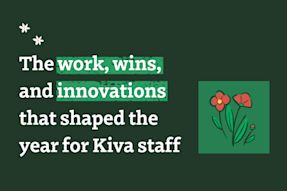For the first time ever, a few lucky and devoted Kiva lenders were extended the opportunity to see Kiva at work on the ground. Recently, 7 lenders visited 2 Kiva Field Partners and their borrowers in Mexico City, as part of our first lender trip to the field. It was a unique and thrilling opportunity to see Kiva dollars at work, transforming lives and communities up close.
This post is the third of a 4 part series, which came to us from the lender trip. This piece was contributed by Michael, who has been lending on Kiva since 2011.
Sistema Biobolsa – Day 3 of the Kiva Lender field trip
My name is Michael, and my involvement with Kiva began in 2011 after Randy Peterson (of www.insideflyer.com) offered to match my first loan and I had traveled enough to understand that hard working individuals around the world struggle to gain access to capital. In a little under six years with Kiva, I’ve now made over 2,500 loans in 83 countries throughout the world with a default rate of less than one-half a percent.
So what’s Sistema Biobolsa?
Sistema Biobolsa manufactures biodigesters to order, keeping no costly inventory in stock, and works with small and medium-size family farms that don’t receive subsidies from the Mexican government. As a social enterprise, the aim of Sistema Biobolsa is a positive impact on society, not profit.
"We talk about people, not numbers. These [farmers] are the individuals who are in touch with nature and have ancestral wisdom. They are actually the richest people in the world because they have everything. They have resources and the earth. They just have barriers." - Sistema Biobolsa staff
Some microfinance institutions charge what would be deemed extortionate interest rates – up to 120% in Mexico! Kiva doesn’t allow rates of this type among their Field Partners in Mexico. As a social enterprise, Sistema Biobolsa's interest rate is precisely zero. Kiva lenders like me and you help make these acquisitions possible for farmers in Mexico. As a social enterprise, there is default risk and the weakening of the Mexican peso has resulted in currency exchange losses. However, the benefits of the system on an actual visit are clear.
 Photo by Berta Vicente
Photo by Berta VicenteSo what’s a biodigester?
A biodigester takes manure and water, converting it into two primary usable by-products:
- Methane, a source of gas energy
- Biol, the liquid byproduct that’s used as a natural fertilizer
Rather than allowing the manure produced by the farm to decay (releasing greenhouse gases) or to dry into chips that are then burned for cooking and bad for health, the biodigester helps eliminate waste, provides gas that can be used for multiple purposes, and generates an easily spreadable form of liquid fertilizer called biol. The biodigester from Sistema Biobolsa lowers the operating costs for farms, provides multiple usable byproducts, improves family health, and protects the environment.
Still wondering how Sistema Biobolsa works?
Check out this YouTube video!
Borrower Stories
Our excursion was truly a field trip from Mexico City. We visited with three borrowers relatively far afield in Tlaxcala, Mexico – these humble, smart farmers graciously welcomed us to their farms and homes and truly couldn’t initially comprehend that a group of individuals located around the world were willing to finance the product on their behalf.
1. Fernando is a highly educated retired primary school teacher and learned about the biodigester from a television program in Mexico. Due to his education, he’s discussed the product with other farmers in the region. He uses the natural biol exclusively on his farm, rather than purchasing any fertilizer at all. "This is much better. The ground is not deteriorating like with previous fertilizer," he shared.
 Photo by Berta Vicente
Photo by Berta Vicente2. David’s farm is entirely committed to dairy, where six cows and too many sheep to count create milk. He is proud that his farm is a complete ecological cycle: 1) He grows alfalfa, clover, and other forage crops, 2) Those crops are food for the cows and sheep, 3) The milk of the animals becomes various dairy products, 4) The manure from the cows and sheep fertilizes the alfalfa, clover, and other crops. When his peers describe his biodigester as almost magical, he responds: "No, this is something sophisticated." -- David
3. Carolina’s family is made up of a total of 13 people, and her farm is much larger, with cows, horses, pigs, turkeys, rabbits, chickens, and ducks coexisting. With so many animals, the day starts early – 5:30 a.m. to be precise. One of the chores of the smallest children is to hop on (massage) the biodigester a few times a day, preventing a layer of solids from forming on top of the biomass. They love this activity, doing somersaults and jumping jacks on the biodigester as if it were a trampoline! If a layer of solids forms, this stops the release of biogas. They let us all jump on the biodigester and try out the "massaging" ourselves! We were treated to a full luncheon that was created solely with products from the farm and cooked on the gas from the biodigester. For many of the field trip participants, this was the first time eating cactus (to universal acclaim). Chicharrones (pig skins) were a step too far with some of the palates on the trip; I went back for thirds.
 Photo by Berta Vicente
Photo by Berta Vicente Photo by Berta Vicente
Photo by Berta Vicente Photo by Berta Vicente
Photo by Berta VicenteWhen we showed the borrowers their Kiva listings with the images and hometowns of the lenders, the entrepreneurs were overwhelmed that so many people throughout the world cared enough about their livelihood to support their new infrastructure. I wish everyone could have the experience of standing on a farm in Tlaxcala at those moments. It’s not a cliché – this is what’s good about humanity, individuals making choices to improve the lives of others. Those who participated in this field trip can attest these entrepreneurs had their livelihoods greatly improved through their Kiva loans.
What did I learn?
My experiences with Kiva in the field have helped me understand how earnest, hardworking individuals around the world make a living when there are few employment opportunities other than self-employment, major international firms, or government. For most rural individuals who aren’t police officers, teachers, or working in one of the few factories, the sole option to create a livelihood is self/family employment.
With these borrowers in Mexico, it’s apparent that the individuals don’t need to learn how to farm. These individuals had all the skills necessary to maximize the productivity of their operations. They simply lacked the access to capital that allowed them to create sustainable farms that lowered their costs.
One of the expressions I heard at a Kiva function years ago was:
Give a person a fish and the person eats for a day.
Teach a person to fish and the person eats for a lifetime.
We’ve all heard that expression right? But there’s just one more part to consider.
What if all the person needs is a net?
PREVIOUS ARTICLE
Tips for success with @SmallBizLady, Melinda Emerson →NEXT ARTICLE
On supporting Latinos AND having her loan funded in under a day →














